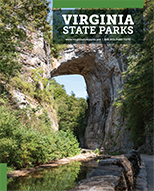Read Our Blogs
Look Whooo we found in the Wood Duck Box
Shared by Grayson Harlow, Education Support Specialist, as Guest Blogger.
At James River State Park, our volunteers have built and installed boxes to provide homes for all kinds of small birds and mammals. We have boxes for flying squirrels, bats, kestrels and bluebirds, among others. This past weekend, Dan Nissen, one of our volunteers, made a fascinating discovery while inspecting the wood duck boxes at Green Hill Pond.
Green Hill Pond at James River State Park
Knowing I would be interested, Dan, sporting his waders, led me out to the first box, planted in a fairly swampy area of the pond. I likely should have been wearing waders as well, as my now-muddy boots can attest. He cracked open the edge of the wood duck box to reveal not a waterfowl, but a sleeping bird we had not expected to find.
Wood Duck box where we found our surprise guests
When I peered into the box, I saw one of my favorite native birds, the eastern screech owl. Not more than seven inches tall, this little raptor took no notice of me or Dan, keeping its little eyes closed against its mottled gray plumage. Its horn-like plumicorns (the feathery tufts atop the head of some species of owl) stood alert, but the tiny owl did not move whatsoever. I remembered the past summer of taking nighttime walks around the pond or the wetlands, listening to the melancholic whinnies and trills of the little raptors, only glimpsing them in gleams of sunset while making their silent flight from tree to tree. Now, in daylight, I was only inches from the mysterious bird, having discovered a sanctuary within which the nocturnal raptors might find solace during the daylight hours.
This Eastern Screech Owl Gray Morph was found in one of our Wood Duck boxes
In the second box, another screech owl enjoyed its daytime respite, although a reddish-brown ornamented its feathers. This was the rufous morph, which might find camouflage among a forest of autumn leaves. The gray morph owl in the first box was the color of tree bark, and may have found a safe home nestled in a tree cavity somewhere, hidden from predators and prey alike.
This rufous morph owl was found in another wood duck box at the park
The smallest of Virginia's native owls, the eastern screech owl can be recognized by its horse-like, melancholic whinny, often heard at dusk or night in woodland areas. The screech owl may appear in one of two color morphs in Virginia: the rufous, or red, morph; and the gray morph. Both morphs inhabit James River State Park, and the two are known to interbreed. The screech commonly nests in hollow tree cavities or nest boxes, and it is easy to see how the gray morph might use its expert camouflage to blend in among gray tree bark, while the rufous morph might hide better among autumn leaves or pine needles. You may have walked by one and never have known it.
The related western screech owl, found west of the Rocky Mountains, only appears as a gray morph, and its call might resemble a bouncing ball. Like all owls, screech owls fly silently, thanks to its specially-adapted, fringed primary feathers, which cause little air turbulence in flight. Screech owls use this adaptation to their advantage to feed on everything from insects and crayfish to small birds, rodents and even bats.
Take a walk around Green Hill Pond and see what you can discover
I will keep my eye on the pond in the coming weeks and months, watching for the noiseless flight of the owls as twilight arrives. In the springtime, we may see screech owls nesting in these wood ducks, using them as a safe haven for their even smaller nestlings. If you happen to visit James River State Park in the near future, listen for the sweet sounds of the screech owls calling, and watch the darkening sky for their silent, predatory flight though the cool night air.
James River State Park is in Buckingham County. Drive time: Northern Va., three hours; Richmond, two hours; Tidewater/Norfolk/Virginia Beach, four hours; Roanoke two hours; Charlottesville, one and a half hours; Lynchburg, 50 minutes. For directions to James River State Park, click here.
If you have read the article and have a question, please email nancy.heltman@dcr.virginia.gov.



















